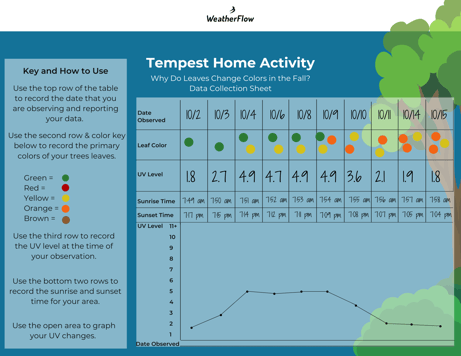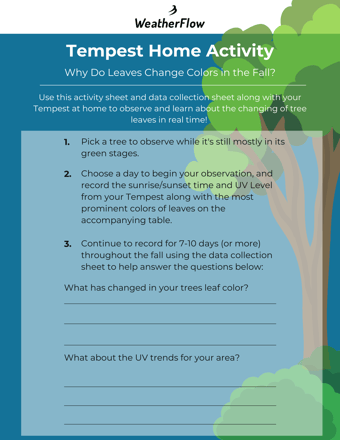Posted by Riley Fenoglio ● October, 2021
Why Do Leaves Change Colors in the Fall?

Days have gotten shorter, the air is cool, and tree leaves are changing colors as many parts of North America experience the fall season. Enthusiasts of the season will be excited to enjoy their favorite fall activities like bonfires, corn mazes, or apple orchard visits - all against the beautiful backdrop of colorful trees filled with vibrant oranges, yellows, and reds.
But what causes the impressive changes in color each year, and why exactly does it happen during the fall season? The answer is simple but might surprise you!
THE TRUTH IS IN THE LEAF
Leaves rely on a commonly known compound called chlorophyll to power photosynthesis and turn sunlight (along with water and carbon dioxide) into energy. Chlorophyll is present in the leaves of every plant species, and its production is triggered throughout the summer months by prolonged sunlight exposure. It is also the reason why leaves are mainly green during that time of year; however, chlorophyll isn’t the only color-producing compound found in plant leaves.
Carotenoids, a pigment found in leaves and other plants like pumpkins and carrots is responsible for the spectacular yellows and oranges we see on leaves in the fall. Rich purples and reds come from anthocyanins, which act slightly differently than carotenoids in that they are not produced in the leaf all year long but produced in preparation for fall by the tree. Finally, when all a leaf’s nutrients have been re-absorbed by the tree and it’s ready to drop, a brownish color is left behind by the leftover tannins found in the leaf.
SENSITIVE TO SUN
So how do the different pigments within the leaf work together to create their spectacular color changes? Weather plays a key role in the process, with sunlight being the driver of the whole operation. Chlorophyll production is amped up into overdrive during the sunny summer months while trees take advantage of the extended daylight hours. However, as fall approaches and the days become shorter, trees begin to take notice and slow their chlorophyll production. As the amount of chlorophyll present in the leaf begins to wane, the more vibrant carotenoids and anthocyanins take center stage and leaves begin to show their hidden colors!
As the season continues on and vibrant fall turns to winter, leaves will make their final color change before dropping from trees for good. Leaves are dropped from most trees during the winter season so that the nutrients they absorbed throughout the summer can be used most effectively by the tree until next spring.
Astronomical Autumn vs Meteorological Autumn
We often mark the beginning of autumn by its noticeable traits: cooler weather, earlier sunsets, later sunrises, colorful leaves, and so on. Many people notice and even celebrate the Autumnal equinox, which usually arrives in mid-September and marks the beginning of those shorter days we mentioned earlier. For them, the equinox signifies the changing of seasons and the beginning of the fall or autumn season. For meteorologists, however, the fall season starts much earlier on September 1st. But why?
The truth here lies in the way that meteorologists define their seasons, which is done by temperature grouping as opposed to the astronomical method which relies on the Earth's tilt. Meteorologists group their seasons into three months based on the average temperature of each month. So for them, seasons throughout the year look like this:
- Winter begins on December 1st, and spans the months of December, January, and February
- Spring begins on March 1st, and spans the months of March, April, and May
- Summer begins on June 1st, and spans the month of June, July, and August
- Fall begins on September 1st, and spans the months of September, October, and November
Astronomical seasons, however, are marked by what we know as the autumnal and vernal (or spring) equinoxes, along with the winter and summer solstices. These seasons are based on the changing position of the Earth in relation to the Sun as the Earth makes its rotation. The Earth’s tilt also plays a role here, determining the angle at which the Sun’s rays will hit the Earth and for how long.

Because the astronomical seasons are determined by the changing position of the relationship between the Earth and Sun, the date that one season ends and another begins can change from year to year. This yearly change would make it difficult for scientists to compare weather and climate data from one year to the next and sparked the creation of the meteorological calendar.
FALLING INTO PLACE
For many North Americans, changing leaves is a staple of the fall season. While there are other factors that contribute to the changes each year like precipitation and temperature, sunlight is the strongest driver in bringing in the bright fall foliage. While we're taking notice of the cooler temperatures and shorter days, so are the trees, who also begin to prepare for a cooler season ahead. Instead of bringing out coats and scarves, however, they show their spectacular colors as they begin to drop their leaves and lay dormant through the winter until warmer days come again.
TEMPEST HOME ACTIVITY
We've put together a fun home activity for Tempest owners and families! Observe the relationship between the colors of the tree leaves in your area with the radiation levels present throughout the fall season. Download the printable versions of this activity below to complete at home with your own data!
Back to: Articles



